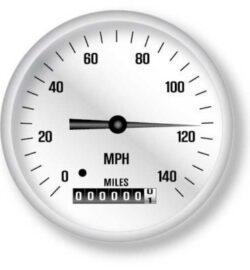Stunt Driving
Stunt Driving Tickets
Stunt driving tickets are issued by police officers for speeding, in the following situations:

- driving in excess of 50km/h
- driving in excess of 40km/h where speed limit is less than 80km/h
- traveling at a rate of speed that is a marked departure of the speed limit
- two (2) or more vehicles traveling at a rate of speed in a marked departure of the speed limit
- outdistancing one or more vehicles while traveling at a rate of speed that is a marked departure of the speed limit
- chasing another vehicle
Stunt Driving – Marked Departure
“Marked Departure” means, driving at a rate of speed that may limit the ability of a driver of a motor vehicle to prudently adjust to changing circumstances on the highway.
This definition is open to interpretation by the police officer, the court system and the Judge.
Stunt driving also covers other events listed in Ontario Regulation 455/07 of the Highway Traffic Act, and is NOT considered a criminal offence, although drivers can be sent to jail.
The offence is a traffic ticket issued under the Highway Traffic Act s.172 which is a provincial law.
Charged with Stunt Driving
Where a police officer charges a driver with stunt driving, the officer will give the driver three (3) documents:
- a summons to appear in court
- a notice that drivers licence has been suspended for 30 days
- a notice of the seizure of the vehicle for 14 days
A summons to appear, is a traffic ticket without a fine. The summons commands the driver or their representative to appear in court before a Justice of the Peace.
The driver must appear in person or may have a licensed paralegal appear on their behalf. If the driver does not appear on the court date, the justice can:
- issue a bench summons
- for the arrest of the driver, or
- convict the driver in their absence
A “Bench Summons” is a court order for the police to arrest the driver to ensure their appearance in court. Once arrested the police must take them into custody and to bring them before a judge forthwith.
Penalty for Stunt Driving
The penalty for stunt driving includes:
- 6 demerit points
- fine between $2,000 – $10,000
- possible jail up to 6 months
- 14 day impoundment of vehicle
- immediate 30 day driver licence suspension
- 1 year suspension upon conviction
- mandatory driver education course
- 100 percent increase to insurance rates
Where a fine is issued for stunt driving, the provincial government adds a 20% surcharge to the total payable for the offence.
Insurance Implications for Stunt Driving
Stunt driving tickets affect the driver’s insurance rates in three ways:
- roadside 30 day suspension
- conviction on driving record
- licence suspension upon conviction
Where the driver is charged with stunt driving, the police officer will immediately suspend the drivers licence for 30 days. This suspension will appear forthwith on the driving record and is available to the insurance.
Insurance companies are not usually notified of the charge, but will see the suspension should they check the record.
Any licence suspension or conviction for stunt driving will dramatically affect insurance rates for 3-5 years.
Stunt driving is not a criminal offence, it is an offence against the traffic laws of the Province of Ontario.
Charged with Stunt Driving – Now What?
Being charged with Stunt Driving is a serious situation, drivers should consider getting legal advice and representation for your court appearance.
Although you maybe able to appear in traffic court yourself, if anything goes wrong or you make a mistake, you could:
- lose your licence for 1 -3 years
- be sentenced to a period of time in jail
- receive a fine up to $10,000
Many Ontario jurisdictions have sent drivers to jail for high speed stunt driving charges, and fines of over $5,000 are not uncommon.
Getting Your Licence Back
Drivers while awaiting the court date can apply to have their licence reinstated.
After the 30 days have past, the driver may attend at any Ministry of Transportation office to have their drivers licence reinstated.
The driver will have to pay a $281 reinstatement fee. The record of the suspension stays on the driver abstract/record for three (3) years.
Getting Your Vehicle Back
After 14 days are past, the driver and/or owner of the vehicle can attend at the auto pound to pick up the vehicle.
The driver will be responsible to pay the cost of towing the vehicle to the pound and a daily fee for storage of the vehicle, the cost will be approx. $700 or more.
The vehicle cannot be released before the 14 days except for 2 exceptions:
- the vehicle was stolen
- the owner can prove to a justice that the vehicle was taken without their consent
Where the vehicle is taken without consent the owner would have to apply for a legal hearing before a justice of the peace. Usually this would take more than 14 days so there is little merit in doing so.
Appearing in Court for Stunt Driving
Set Date
Stunt charges have a first court date, commonly called by the court a “Set Date”.
A “set date hearing” is a court date for the driver to either plead guilty or not guilty to the charge.
If the driver pleads guilty to stunt driving, the justice gives the driver the penalties set for those convicted of stunt driving.
Should the driver plead not guilty or to wish to seek legal advice, then the judge would adjourn the case to another court date, commonly called a “To Be Spoken To Date” or TBST.
On the first court appearance the prosecutor will usually give the defendant or their representative the disclosure.
Disclosure is a group of documents containing the officers notes, the driving record of the defendant and any other pertinent information regarding the charge.
To Be Spoken to Dates
To be spoken to dates (TBST) are usually arranged 2-4 weeks after the set date.
During this time the driver is expected to have reviewed the officers notes (disclosure) and have received legal advice or representation.
On the TBST date the prosecutor is looking to have the driver plead guilty to the charge or set a date for trial.
Where a legal representative has been retained, the representative may discuss with the prosecutor the:
- merits of the officers charge
- any shortcomings or lack of evidence required
- possible resolutions to the charge
Many times having a representative familiar with experience in negotiations, trials, law and court proceedings ensures the best outcomes.
Trial Dates
Where the stunt driving charge goes to trial the case will be scheduled after all other hearings.
On the trial date the police officer must attend and present their evidence to the court. The prosecutor will assist the officer in presenting the case to the judge.
The prosecutor’s job like the name suggests is to prosecute and convict the driver of stunt driving.
The prosecutor is not in court to assist the driver, and there is no legal aid or duty counsel for traffic court.
Likewise drivers should be equally represented by a person who knows how to run a trial, rules of evidence and how to cross-examine a police officer.


